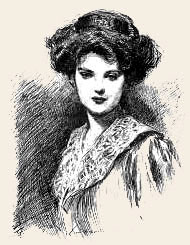
|
|



Fashion
and Cosmetics
 |
Today’s
supermodels wouldn’t always have been considered beautiful.
Standards of beauty have shifted radically over time. During
the 1830s, a popular ideal of feminine beauty was the demure
woman, with wasp-waist, rosebud mouth, wispy fingers, and
tiny feet. After the Civil War, a popular ideal was of a woman
who was curvaceous, big-hipped, and buxom. In the 1890s and
early twentieth century, the aristocratic and sporty Gibson
Girl was a popular ideal. The Gibson Girl was known as the
century's first pin up. |
The
Day Dreamer by Charles Gibson, 1909 |
| First
sketched by Charles Dana Gibson in 1902, this imaginary woman
was to represent the ideal woman. She became known as the
liberated young woman with the characteristic upswept hairdo.
Created using a combination of the Marcel wave and postiche,
the Gibson Girl look was to last a quarter of a century. The
hair style consisted of a soft pompadour, puffed for a cloud
effect, rolled from temple to temple over a horsehair rat
to give it the width that went well with a tiny waist. In
the 1920s, a new ideal was the boyish, buoyant Flapper. |
|
Not
Worrying About Her Rights
by Charles Gibson, 1909 |
Key
Questions:
1.
How would you explain changes in ideals of beauty changed over
time?
2.
At particular moments in American history, dress and appearance
have become the subjects of contention. One might examine the
debate that surrounded bloomers, beauty pageants, swimsuits
and pants for women, and jeans and sandals.
3.
How has social class and age been reflected in clothing?
4.
How have the young used style as a form of protest?
Resources:
|
Copyright
Digital History 2021
|
|
|
